OpenBiodiv-O: ontology of the OpenBiodiv knowledge management system
- PMID: 29347997
- PMCID: PMC5774086
- DOI: 10.1186/s13326-017-0174-5
OpenBiodiv-O: ontology of the OpenBiodiv knowledge management system
Abstract
Background: The biodiversity domain, and in particular biological taxonomy, is moving in the direction of semantization of its research outputs. The present work introduces OpenBiodiv-O, the ontology that serves as the basis of the OpenBiodiv Knowledge Management System. Our intent is to provide an ontology that fills the gaps between ontologies for biodiversity resources, such as DarwinCore-based ontologies, and semantic publishing ontologies, such as the SPAR Ontologies. We bridge this gap by providing an ontology focusing on biological taxonomy.
Results: OpenBiodiv-O introduces classes, properties, and axioms in the domains of scholarly biodiversity publishing and biological taxonomy and aligns them with several important domain ontologies (FaBiO, DoCO, DwC, Darwin-SW, NOMEN, ENVO). By doing so, it bridges the ontological gap across scholarly biodiversity publishing and biological taxonomy and allows for the creation of a Linked Open Dataset (LOD) of biodiversity information (a biodiversity knowledge graph) and enables the creation of the OpenBiodiv Knowledge Management System. A key feature of the ontology is that it is an ontology of the scientific process of biological taxonomy and not of any particular state of knowledge. This feature allows it to express a multiplicity of scientific opinions. The resulting OpenBiodiv knowledge system may gain a high level of trust in the scientific community as it does not force a scientific opinion on its users (e.g. practicing taxonomists, library researchers, etc.), but rather provides the tools for experts to encode different views as science progresses.
Conclusions: OpenBiodiv-O provides a conceptual model of the structure of a biodiversity publication and the development of related taxonomic concepts. It also serves as the basis for the OpenBiodiv Knowledge Management System.
Keywords: Biodiversity; Biodiversity informatics; Biological systematics; Concept taxonomy; Data modeling; Knowledge management; Linked open data; OWL; Ontology; RDF; Semantic publishing; Semantic web; Taxonomy.
Conflict of interest statement
Ethics approval and consent to participate
Not applicable
Consent for publication
Not applicable
Competing interests
The authors declare that they have no competing interests.
Publisher’s Note
Springer Nature remains neutral with regard to jurisdictional claims in published maps and institutional affiliations.
Figures
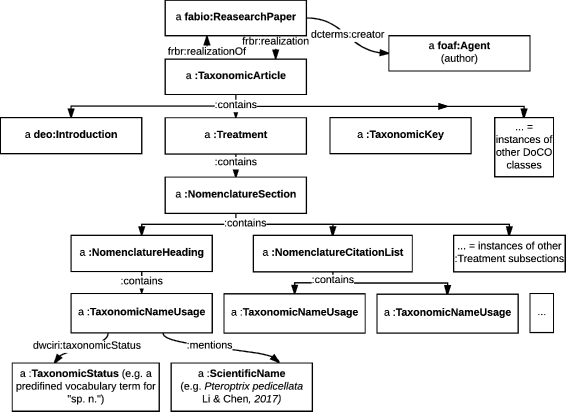
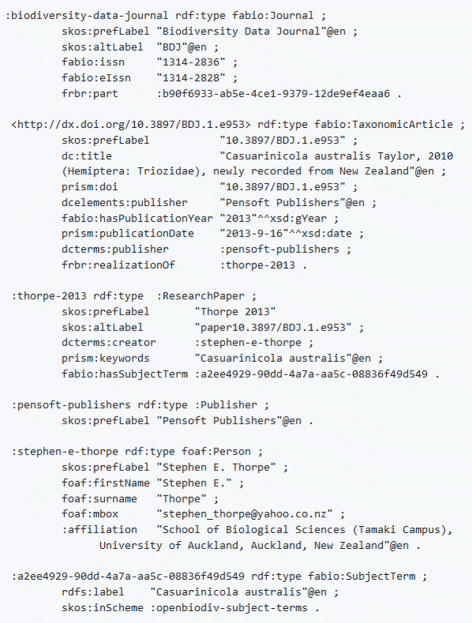
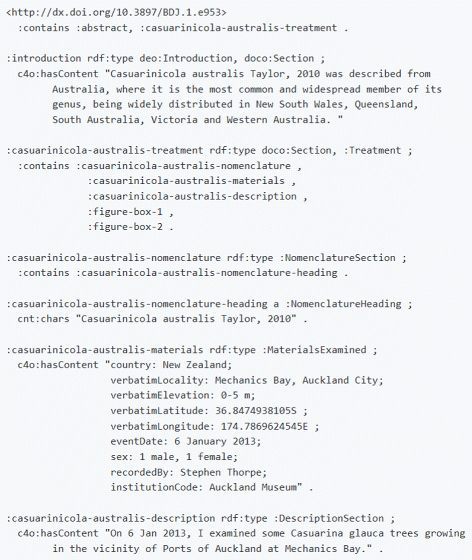
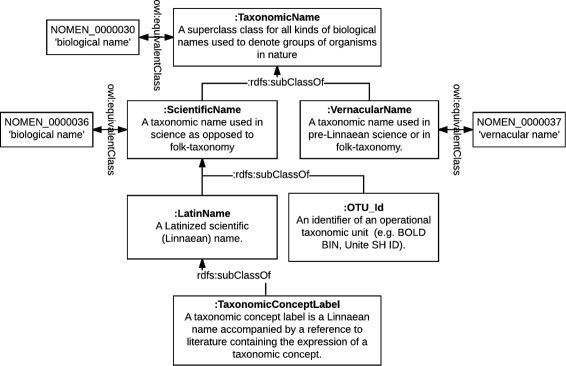

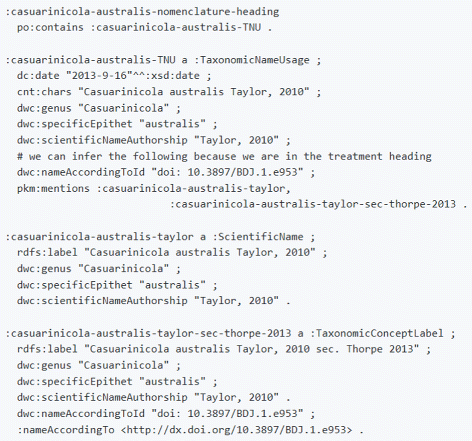
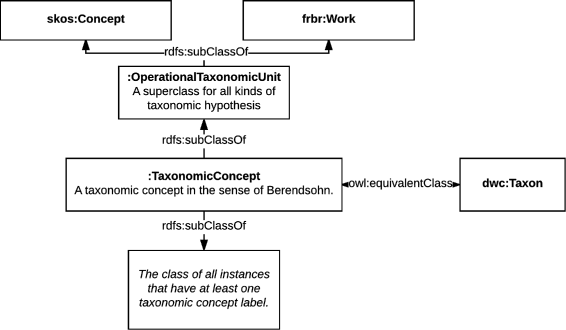
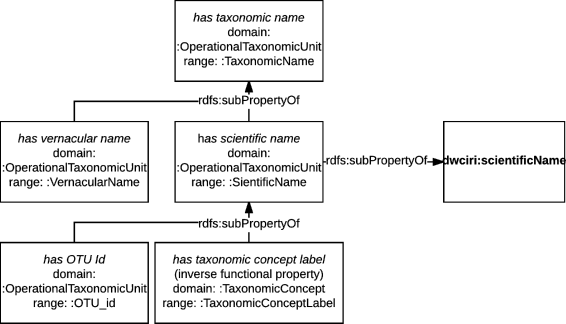
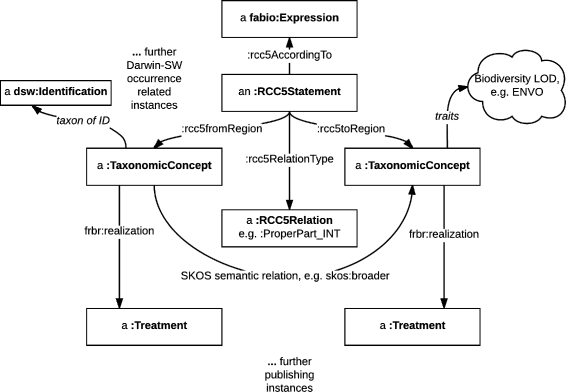




Similar articles
-
Infrastructure and Population of the OpenBiodiv Biodiversity Knowledge Graph.Biodivers Data J. 2021 Sep 24;9:e67671. doi: 10.3897/BDJ.9.e67671. eCollection 2021. Biodivers Data J. 2021. PMID: 34690512 Free PMC article.
-
Automated ontology generation framework powered by linked biomedical ontologies for disease-drug domain.Comput Methods Programs Biomed. 2018 Oct;165:117-128. doi: 10.1016/j.cmpb.2018.08.010. Epub 2018 Aug 16. Comput Methods Programs Biomed. 2018. PMID: 30337066
-
Semantics in support of biodiversity knowledge discovery: an introduction to the biological collections ontology and related ontologies.PLoS One. 2014 Mar 3;9(3):e89606. doi: 10.1371/journal.pone.0089606. eCollection 2014. PLoS One. 2014. PMID: 24595056 Free PMC article.
-
Assessing the practice of biomedical ontology evaluation: Gaps and opportunities.J Biomed Inform. 2018 Apr;80:1-13. doi: 10.1016/j.jbi.2018.02.010. Epub 2018 Feb 17. J Biomed Inform. 2018. PMID: 29462669 Free PMC article. Review.
-
The ontology life cycle: Integrated tools for editing, publishing, peer review, and evolution of ontologies.AMIA Annu Symp Proc. 2010 Nov 13;2010:552-6. AMIA Annu Symp Proc. 2010. PMID: 21347039 Free PMC article. Review.
Cited by
-
Knowledge-Based Biomedical Data Science.Annu Rev Biomed Data Sci. 2020 Jul;3:23-41. doi: 10.1146/annurev-biodatasci-010820-091627. Epub 2020 Apr 7. Annu Rev Biomed Data Sci. 2020. PMID: 33954284 Free PMC article.
-
Infrastructure and Population of the OpenBiodiv Biodiversity Knowledge Graph.Biodivers Data J. 2021 Sep 24;9:e67671. doi: 10.3897/BDJ.9.e67671. eCollection 2021. Biodivers Data J. 2021. PMID: 34690512 Free PMC article.
-
Wanted: Standards for FAIR taxonomic concept representations and relationships.Biodivers Inf Sci Stand. 2021;5:e75587. doi: 10.3897/biss.5.75587. Epub 2021 Sep 23. Biodivers Inf Sci Stand. 2021. PMID: 35462676 Free PMC article.
-
Biodiversity Observations Miner: A web application to unlock primary biodiversity data from published literature.Biodivers Data J. 2019 Jan 16;(7):e28737. doi: 10.3897/BDJ.7.e28737. eCollection 2019. Biodivers Data J. 2019. PMID: 30692868 Free PMC article.
-
taxalogue: a toolkit to create comprehensive CO1 reference databases.PeerJ. 2023 Dec 4;11:e16253. doi: 10.7717/peerj.16253. eCollection 2023. PeerJ. 2023. PMID: 38077427 Free PMC article.
References
-
- TDWG Past Meetings. http://www.tdwg.org/past-meetings/. Accessed 12 Aug 2017.
-
- What is GBIF. http://www.gbif.org/what-is-gbif. Accessed 12 Aug 2017.
-
- Bouchout Declaration. http://www.bouchoutdeclaration.org. Accessed 09 Aug 2017.
-
- pro-iBiosphere. http://wiki.pro-ibiosphere.eu/. Accessed 12 Aug 2017.
Publication types
MeSH terms
LinkOut - more resources
Full Text Sources
Other Literature Sources
Miscellaneous

